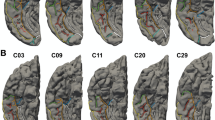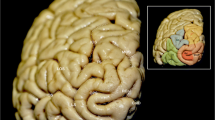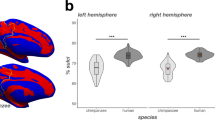Abstract
In order to evaluate the extent of the subdivisions of Neanderthal brains, we explored methods to determine the extent of subdivisions of brains in extant primate species. In the present study, we analyzed skulls and brains of macaque monkeys (Macaca fascicularis). Under deep anesthesia, five aged monkeys were perfused transcardially with phosphate-buffered 10 % formalin. The heads were scanned using a Toshiba Asterion CT scanner, and the reconstructed skulls and endocasts were compared with the convolutional patterns of the brain. In contrast to adult humans, which barely exhibit impressions in the upper part of the calvaria, the endocasts of the monkey skulls showed marked impressions of the cerebral sulci and gyri through the entire surface. On the dorsolateral surface, we identified most of the major sulci including the principal, arcuate, central, intraparietal, lunate, lateral, and superior temporal sulci, as well as the gyri in-between. On the ventral surface, we identified the medial and lateral orbital sulci, and the anterior middle temporal sulcus. Some of the individual differences in sulcal patterns were also observed on the endocast surface. We can thus infer the extent of major subdivisions of the macaque cerebral cortex by creating endocasts.
Access this chapter
Tax calculation will be finalised at checkout
Purchases are for personal use only
Similar content being viewed by others
References
Anthony R (1913) L’encéphale de l’homme fossile de la Quina. Bulletins et Mémoires de la Société d’anthropologie de Paris 4:117–195
Balzeau A, Grimaud-Herve D, Jacob T (2005) Internal cranial features of the Mojokerto child fossil (East Java, Indonesia). J Hum Evol 48:535–553
Boule M (1917) Neopallial morphology of fossil men as studied from endocranial casts. J Anat 51:95–102
Bruner E (2003) Fossil traces of the human thought: paleoneurology and the evolution of the genus Homo. Rivista di Antropologia 81:29–56
Carlson KJ, Stout D, Jashashvili T, de Ruiter DJ, Tafforeau P, Carlson K, Berger LR (2011) The endocast of MH1, Australopithecus sediba. Science 333:1402–1407
Dart RA (1925) Australopithecus africanus: The Man-Ape of South Africa. Nature 115:195–199
Dart RA (1940) The status of Australopithecus. Am J Phys Anthropol 26:167–186
Dubois E (1937) On the fossil human skulls recently discovered in Java and Pithecanthropus erectus. Man 37:1–7
Falk D (1980) A reanalysis of the South African australopithecine natural endocasts. Am J Phys Anthropol 53:525–539
Falk D (1983) The Taung endocast: a reply to Holloway. Am J Phys Anthropol 60:479–489
Holloway RL (1980) Revisiting the South African Taung australopithecine endocast: the position of the lunate sulcus as determined by the stereoplotting technique. Am J Phys Anthropol 56:43–58
Holloway RL, Broadfield DC, Yuan MS (2004) The human fossil record. Schwartz JH, & Tattersall I (eds). Brain Endocasts - The Paleoneurological Evidence. Wiley, New York, Vol. 3,
Le Gros Clark WE (1945) Note on the palaeontology of the lemuroid brain. J Anat 79:123–126
Le Gros Clark WE, Cooper DM, Zuckerman S (1936) The endocranial cast of the chimpanzee. J R Anthropol Inst 66:249–268
Ogawa T, Kamiya T, Sakai S, Hosokawa H (1970) Some observation on the endocranial cast of the Amud man. In: Suzuki H, Takai F (eds) The Amud Man and his Cave Site. The University of Tokyo Press, Tokyo, pp 411–424
Radinsky L (1974) The fossil evidence of anthropoid brain evolution. Am J Phys Anthropol 41(1):15–27
Shellshear JL, Smith GE (1934) A Comparative Study of the Endocranial Cast of Sinanthropus. Philos Trans R Soc Lond B Biol Sci 223:469–487
Smith-Agreda V (1955) Über die Verteilung der Impressiones gyrorum an der Innenseite des Gehirnschädels des Menschen. Mit Benützung von Endokranialausgüssen. Deutsche Zeitschrift für Nervenheilkunde 173:37–68
Symington J (1916) Endocranial casts and brain form: a criticism of some recent speculations. J Anat Physiol 50:111–130
Acknowledgments
We thank Dr. Fuhito Hojo at the Animal Research Facilities, Kyorin University School of Medicine, for his valuable advice regarding animal experimental procedures. This study was partly supported by a Grant-in-Aid for Scientific Research on Innovative Areas (Grant No. 23101509) from the Japanese Ministry of Education, Science, Culture, and Technology.
Author information
Authors and Affiliations
Corresponding author
Editor information
Editors and Affiliations
Rights and permissions
Copyright information
© 2014 Springer Japan
About this chapter
Cite this chapter
Kobayashi, Y., Matsui, T., Haizuka, Y., Ogihara, N., Hirai, N., Matsumura, G. (2014). Cerebral Sulci and Gyri Observed on Macaque Endocasts. In: Akazawa, T., Ogihara, N., C Tanabe, H., Terashima, H. (eds) Dynamics of Learning in Neanderthals and Modern Humans Volume 2. Replacement of Neanderthals by Modern Humans Series. Springer, Tokyo. https://doi.org/10.1007/978-4-431-54553-8_14
Download citation
DOI: https://doi.org/10.1007/978-4-431-54553-8_14
Published:
Publisher Name: Springer, Tokyo
Print ISBN: 978-4-431-54552-1
Online ISBN: 978-4-431-54553-8
eBook Packages: Humanities, Social Sciences and LawSocial Sciences (R0)




